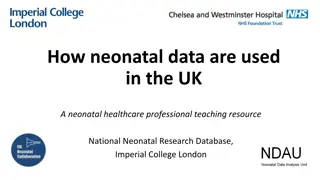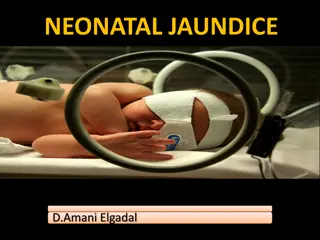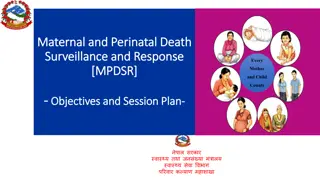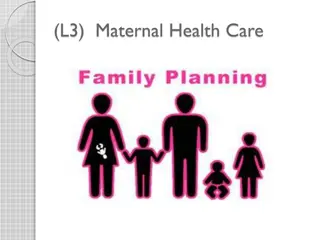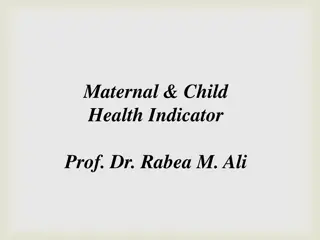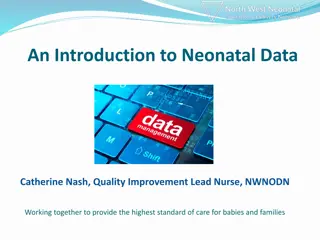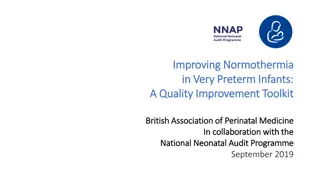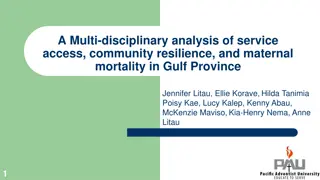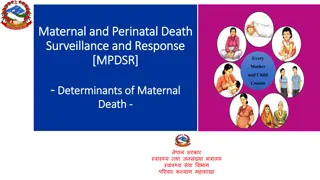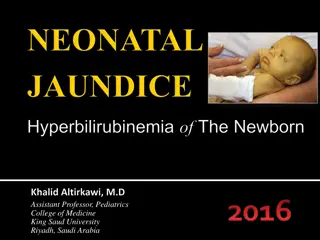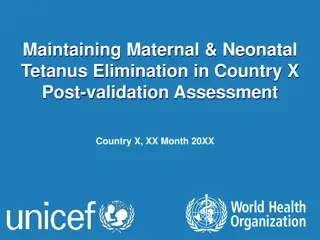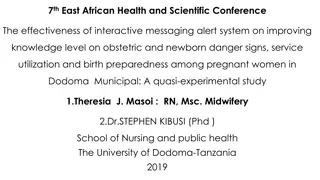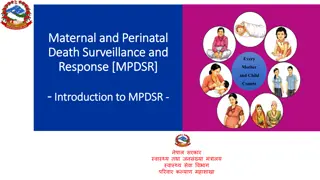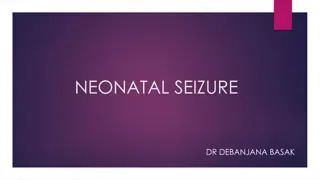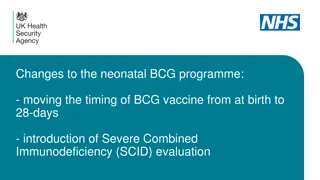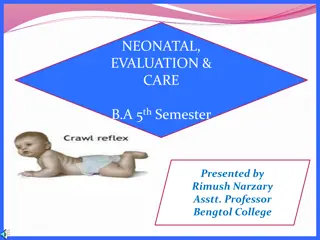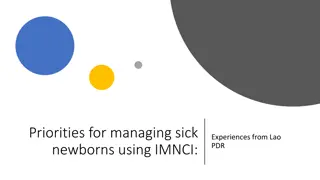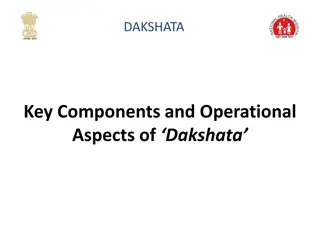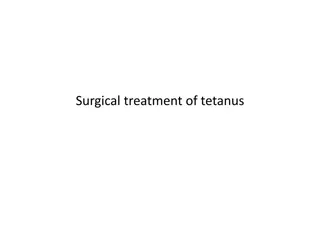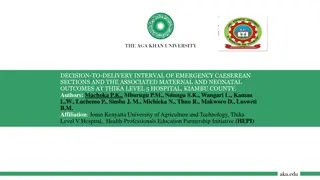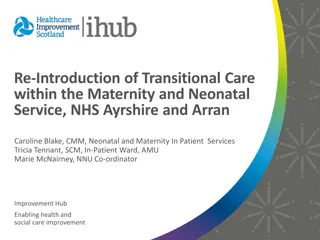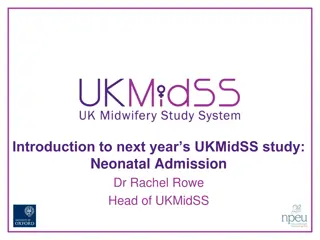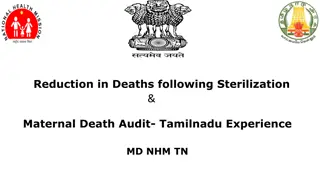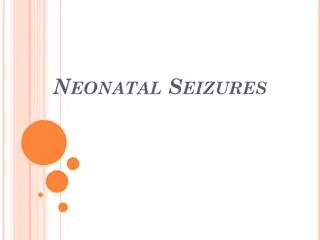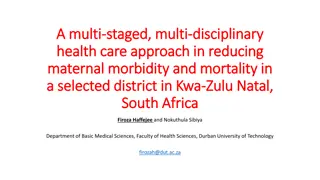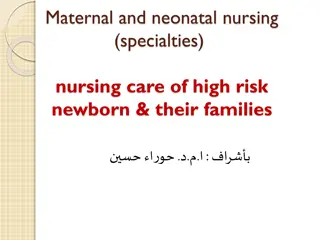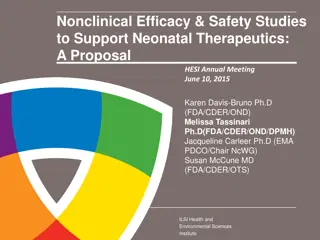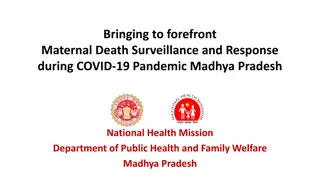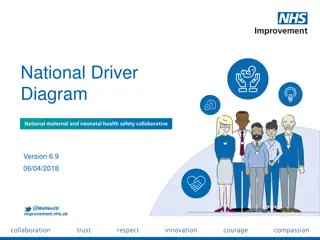Understanding Neonatal Data Usage in the UK Healthcare System
Neonatal data plays a crucial role in assessing the quality of care provided to newborns in the UK. This resource from the National Neonatal Research Database at Imperial College London sheds light on how neonatal data is collected, utilized, and shared among healthcare professionals. The importance
1 views • 24 slides
NEONATAL JAUNDICE
Neonatal jaundice, a common condition in newborns, results from elevated bilirubin levels. While often benign, high levels can lead to complications like kernicterus. Recognizing risk factors, limitations of clinical assessment, and appropriate evaluation and treatment are crucial in managing neonat
1 views • 48 slides
Maternal Mortality Crisis in the U.S.: Urgent Need for Healthcare Reform
Maternal mortality rates in the United States have significantly increased over the years, with racial disparities exacerbating the issue. The data shows a concerning rise in both maternal and infant mortality, highlighting the critical need for comprehensive healthcare reform to address these alarm
4 views • 25 slides
Maternal and Perinatal Death Surveillance and Response Orientation Program
This orientation program aims to equip participants with the knowledge and skills to understand and effectively implement Maternal and Perinatal Death Surveillance and Response (MPDSR) in hospitals. Participants will learn the rationale and process of MPDSR, complete review forms accurately, identif
1 views • 5 slides
Maternal Health Care and Family Planning Overview
Maternal health care and family planning are essential components of reproductive health. Family planning helps individuals achieve various objectives like avoiding unwanted pregnancies, controlling the timing and number of children, and regulating pregnancy intervals. The health benefits include pr
0 views • 19 slides
Maternal and Child Health Indicators: Objectives and Mortality Rates
Maternal and Child Health (MCH) services aim for the reduction of maternal, perinatal, infant, and childhood mortality and morbidity, promotion of reproductive health, and physical and psychological development of children and adolescents within families. The indicators focus on mortality rates, inc
0 views • 31 slides
Importance of Preconception Care for Maternal and Child Health
Preconception care involves biomedical interventions provided to women and couples before conception to improve their health status and reduce factors contributing to poor maternal and child health outcomes. It aims to enhance maternal and child health in both the short and long term by addressing p
0 views • 14 slides
Neonatal Diseases
Neonatal and postnatal diseases in livestock, with a focus on perinatal, neonatal, and postnatal stages. It covers common classifications, causes, and risk factors associated with these diseases, particularly focusing on neonatal diarrhea (Calf Scour). The content delves into noninfectious and infec
0 views • 33 slides
Neonatal Data Collection and Utilization in Quality Care
Dive into the world of neonatal data with Catherine Nash, where the focus lies on the importance of collecting and utilizing data effectively to enhance care standards for babies and families. Discover how data systems like BadgerNet play a vital role in monitoring care, diagnosing treatments, measu
0 views • 7 slides
Quality Improvement Toolkit for Improving Normothermia in Very Preterm Infants
This resource provides a comprehensive toolkit developed by the British Association of Perinatal Medicine in collaboration with the National Neonatal Audit Programme to assist clinicians in neonatal units in delivering normothermia to very preterm infants. It includes evidence-based interventions, d
1 views • 17 slides
Maternity and Neonatal Safety Improvement Programme Overview
The Maternity and Neonatal Safety Improvement Programme aims to enhance the quality and safety of maternity and neonatal units in England by reducing rates of maternal and neonatal deaths, stillbirths, and brain injuries. Through system-level project updates and regional collaborative efforts, the p
2 views • 70 slides
A Multi-disciplinary Analysis of Service Access, Community Resilience, and Maternal Mortality in Gulf Province
This paper presents a comprehensive analysis focusing on service access, community resilience, and maternal mortality in Gulf Province, Papua New Guinea. It highlights the importance of improving referral systems for maternal health in remote communities and discusses the preliminary findings from a
1 views • 53 slides
Neonatal Care at Lagos University Teaching Hospital (LUTH)
Lagos University Teaching Hospital (LUTH) is a tertiary referral center providing comprehensive neonatal care services. The facility has specialized units for inborn and outborn babies, offering advanced medical care, including neonatologists, resident doctors, nurses, and support staff. LUTH also h
0 views • 15 slides
Understanding Determinants of Maternal Death: Causes, Factors, and Response
This educational session delves into the determinants of maternal death, distinguishing between causes and factors that increase the risk of maternal mortality. It covers possible determinants like hemorrhage, sepsis, and poor access to healthcare services, and discusses the Three Delays model for i
0 views • 18 slides
Understanding Neonatal Jaundice: A Guide for Medical Students
This presentation by Dr. Khalid Altirkawi, M.D., Assistant Professor of Pediatrics, aims to educate medical students on neonatal jaundice. The content covers metabolic pathways of bilirubin, types of jaundice, diagnostic tests, prevention, and treatment strategies. It provides valuable insights into
0 views • 52 slides
Maintaining Maternal & Neonatal Tetanus Elimination: Post-validation Assessment in Country X
This post-validation assessment report delves into the efforts to maintain Maternal & Neonatal Tetanus Elimination in Country X. It includes findings from field assessments, recommendations for sustaining the elimination status, and the critical role of surveillance in addressing vulnerable populati
3 views • 19 slides
Understanding Tetanus: Causes, Symptoms, and Diagnosis
Tetanus, also known as Locked Jaw or Saw Horse disease, is a highly fatal condition in domestic animals caused by the neurotoxin produced by Clostridium tetani. The disease is characterized by hyperaesthesia, tetany, and convulsions. Transmission occurs through contaminated soil, typically from hors
0 views • 10 slides
Effectiveness of Interactive Messaging Alert System in Improving Maternal Health Knowledge
This study evaluates the impact of an Interactive Messaging Alert System (IMAS) on enhancing knowledge levels of obstetric and newborn danger signs, increasing antenatal care service utilization, and improving birth preparedness among pregnant women in Dodoma Municipal. By addressing the three core
2 views • 16 slides
Maternal and Perinatal Death Surveillance and Response (MPDSR) in Nepal
Explore the maternal and perinatal mortality status in Nepal, learn about the MPDSR's rationale, goal, components, and implementation status. Dive into a case scenario highlighting maternal deaths, background on maternal mortality, and global statistics, emphasizing the importance of improving mater
0 views • 40 slides
Understanding Neonatal Seizures and Their Pathophysiology
Neonatal seizures are sudden changes in neurologic function of a newborn, involving motor, behavior, and autonomic functions. The pathophysiology includes delays in Na/K ATPase maturation, increased receptor density, and GABAergic transmission. Different types of seizures like subtle, clonic, tonic,
1 views • 24 slides
Changes to Neonatal BCG Programme: Updated Timing and SCID Evaluation
The Neonatal BCG Programme has undergone changes, including shifting the timing of the BCG vaccine administration from birth to 28 days and introducing Severe Combined Immunodeficiency (SCID) evaluation. This session aims to educate on the modifications for safe practice. The BCG immunization progra
1 views • 12 slides
Understanding the Neonatal Period: Care and Evaluation
The neonatal period, also known as the newborn stage, encompasses the first 28 days of a baby’s life, characterized by rapid changes and fragility. This crucial stage requires specialized care, with sub-divisions such as the Period of the Partunate and Period of the Neonate. Commonly, neonates may
0 views • 19 slides
Global Maternal Health and COVID-19 Impact Briefing by Women's Congressional Policy Institute
The virtual briefing series hosted by Women's Congressional Policy Institute on Global Maternal Health and the Impact of COVID-19 featured speakers discussing the challenges, initiatives, and collaborations to improve maternal health worldwide. Notable speakers included Cindy Hall from WCPI, Stacey
0 views • 6 slides
Insights on Improving Newborn Care with IMNCI in Lao PDR
Under-5 mortality rates are showing improvement, yet neonatal mortality lags behind. Addressing this requires a focus on neonatal care, particularly through the implementation of IMNCI protocols. The use of IMNCI can enhance the management of sick newborns, reduce neonatal deaths, and improve overal
0 views • 16 slides
Maternal and Neonatal Healthcare Insights
The data highlights key components, operational aspects, major causes, and timing of maternal and neonatal deaths. It emphasizes the critical period around delivery for both mothers and babies, stressing the need for interventions during this vulnerable time to reduce mortality rates. The informatio
0 views • 28 slides
Understanding Tetanus: Causes, Symptoms, and Treatment
Tetanus, also known as lockjaw, is a bacterial infection characterized by muscle spasms that can lead to severe complications. It is caused by the bacterium Clostridium tetani, commonly found in soil, saliva, and manure. Symptoms include muscle spasms, lockjaw, and difficulty swallowing. Tetanus can
0 views • 10 slides
Decision-to-Delivery Interval of Emergency Caesarean Sections and Maternal/Neonatal Outcomes at Thika Level 5 Hospital
Decision-to-Delivery Interval (DDI) study at Thika Level 5 Hospital examined 419 EMCS cases. The median DDI was 248 minutes, with 91.6% exceeding 75 minutes. Maternal complications were 6%, neonatal complications included MAS, RDS, birth asphyxia, and perinatal deaths. Prolonged DDI was associated w
0 views • 9 slides
Maternal Work Hours and Adolescent Obesity: A Longitudinal Analysis
This study investigates the relationship between increased maternal work hours during childhood and adolescent obesity. It explores how maternal employment and income levels may impact the rates of adolescent obesity, utilizing data from the Panel Survey of Income Dynamics and Child Development Surv
0 views • 12 slides
Enhancing Transitional Care in Maternity and Neonatal Services at NHS Ayrshire and Arran
This project focused on reintroducing transitional care within the Maternity and Neonatal Service at NHS Ayrshire and Arran, aiming to enhance family satisfaction, reduce term admissions to the Neonatal Unit, and improve the overall care provided to families. Key strategies included changes in ward
0 views • 10 slides
Neonatal Admission Study: Understanding Risk Factors in Midwifery Settings
Neonatal Admission Study led by Dr. Rachel Rowe aims to investigate the admission of babies to neonatal care following birth in midwifery units. The study focuses on identifying risk factors and potential improvements in outcomes. The case-control study involves monthly data collection for 12 months
0 views • 10 slides
Reduction in Deaths following Sterilization & Maternal Death Audit - Tamilnadu Experience
Tamilnadu has successfully achieved replacement levels of fertility and focuses on promoting maternal health through various contraceptive practices. The state conducts audits to identify causes of sterilization deaths, with a major emphasis on improving maternal health care to reduce mortality rate
0 views • 25 slides
Maternal Effect on Shell Coiling in Snails
Maternal effects play a crucial role in determining the coiling direction of snail shells. The maternal inheritance of organelle genes controls certain traits in offspring, with the direction of shell coiling being a classic phenotype exhibiting maternal effects. The genotype of the female parent de
0 views • 7 slides
Understanding Neonatal Seizures and Differentiating from Jitteriness
Neonatal seizures are a critical sign of neurologic dysfunction in newborns, with various types such as subtle, clonic, tonic, spasms, and myoclonic seizures. The immature brain's excitability and differences from the mature brain predispose neonates to seizures. Generalized clonic seizures are rare
0 views • 17 slides
Join Trick-or-Treat for UNICEF to Eliminate Maternal and Neonatal Tetanus
Key Club and UNICEF are collaborating through Trick-or-Treat for UNICEF to help eradicate Maternal and Neonatal Tetanus (MNT). This initiative has raised over $175 million since 1950. Maternal/Neonatal Tetanus affects millions globally due to unsanitary birthing conditions. Learn how to get involved
0 views • 5 slides
Addressing Maternal Morbidity and Mortality in KwaZulu-Natal, South Africa: A Multi-Staged Approach
This study focuses on reducing maternal morbidity and mortality rates in KwaZulu-Natal, South Africa, which remain unacceptably high. The research by Firoza Haffejee and Nokuthula Sibiya highlights the need for a comprehensive, multi-disciplinary healthcare strategy to tackle the various factors con
0 views • 31 slides
High-Risk Newborn Nursing Care and Factors
Maternal and neonatal nursing specialties focus on providing care for high-risk newborns and their families, who face conditions endangering the neonate's survival. Factors contributing to high-risk newborns include high-risk pregnancies, maternal medical illnesses like diabetes, labor complications
0 views • 25 slides
Association Between Maternal Education and Maternal Age in GLM Analysis
In this lecture on Generalized Linear Models in R, the focus is on examining the association between maternal education and maternal age using a dataset on births. The process involves creating a factor variable for maternal education levels, filtering a smaller dataset, visualizing the univariate r
0 views • 43 slides
Challenges in Supporting Neonatal Therapeutics: A Proposal Overview
Proposal presentation at HESI Annual Meeting discusses challenges in neonatal therapeutics, including off-label drug use in NICU, low clinical relevance in studies, and barriers to conducting neonatal trials. Mandates require inclusion of neonates in pediatric studies, but priorities and study desig
0 views • 22 slides
Maternal Death Surveillance and Response in Madhya Pradesh During COVID-19
Madhya Pradesh faces challenges in reducing maternal mortality rates, especially during the COVID-19 pandemic. Despite initiatives like the Maternal Death and Surveillance Review program, compliance at the district level has been lacking. To address this, online interventions and state-level reviews
0 views • 17 slides
Enhancing Maternal and Neonatal Healthcare Improvements
This initiative aims to improve the safety and outcomes of maternal and neonatal care in England by reducing unwarranted variations, providing high-quality healthcare experiences, and enhancing systems and processes for better care. Key focuses include promoting smoke-free pregnancies, optimizing ca
0 views • 7 slides
